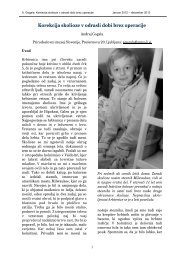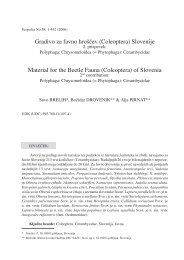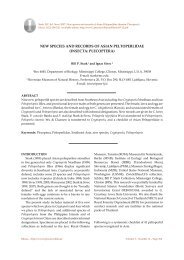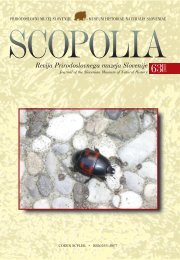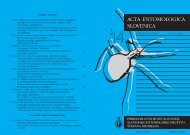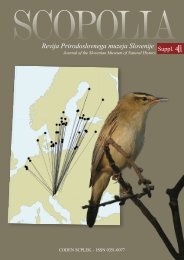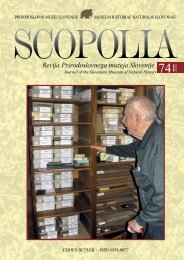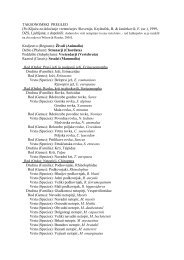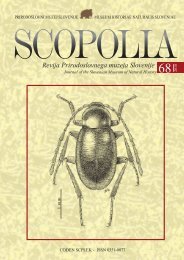Vsebina / Content (.pdf) - Prirodoslovni muzej Slovenije
Vsebina / Content (.pdf) - Prirodoslovni muzej Slovenije
Vsebina / Content (.pdf) - Prirodoslovni muzej Slovenije
You also want an ePaper? Increase the reach of your titles
YUMPU automatically turns print PDFs into web optimized ePapers that Google loves.
Acta entomologica slovenica, 18 (2), 2010<br />
teristic of the investigated forest of the Tinjan hill is its ground with many flat, stratified<br />
stones, having many crevices representing potential nest sites for M. gordiagini<br />
and its hosts. So even though only one M. gordiagini colony was found during the<br />
inspection in 2009, it can be assumed that the local habitat is favourable for this species<br />
and that more colonies could be present there. Generally, nests of parasitic species<br />
rarely occur in isolation, so if one has been detected then more colonies could<br />
be expected in the vicinity (Buschinger 1997). M. gordiagini is probably present in<br />
similar habitats in the nearby areas, including the neighbouring Italy (Trieste region),<br />
where it has not been registered yet (Rigato pers. comm.).<br />
The record from Slovenia can be treated as a part of the southeastern European<br />
part of the distribution area of M. gordiagini, which extends from Istria towards the<br />
southern Balkans (Greece and Bulgaria). Along the eastern coast of the Adriatic, this<br />
species is expected to be more common than could be concluded from known localities.<br />
In this kind of parasitic species, it is usual that they are found in more or less<br />
isolated patches within the range of their hosts and these patches are often characterized<br />
by particularly high densities of the host species (Buschinger 2009).<br />
The host of M. gordiagini colonies in Croatia, Montenegro and Bulgaria, as<br />
reported by Buschinger et al. (1983) and Buschinger & Douwes (1993), was T. lichtensteini.<br />
In the laboratory experiments it was shown that M. gordiagini queens were<br />
all killed when they were placed together with the colonies of T. parvulus (Schenck,<br />
1852) (Buschinger et al. 1983). However, the real identity of these two mentioned<br />
Temnothorax species can be put into question after taxonomic changes introduced by<br />
Seifert (2007). In his taxonomic key, other characters than in older literature are used<br />
to distinguish between three very similar species, i.e. T. parvulus, T. lichtensteini and<br />
still undescribed T. lichtensteini sp. 2, which are indicated here as the »T. lichtensteini/parvulus<br />
group«. It is relatively difficult to distinguish between these three<br />
species if only workers are available, but more clear separation is apparent in queens.<br />
Since in both parasitized colonies from Tinjan Temnothorax queens were not present<br />
(they were eliminated by Myrmoxenus queen), clear identification of the host colonies<br />
was not possible, although workers showed to be closer to T. lichtensteini or T.<br />
lichtensteini sp. 2. Nevertheless, in our case it can be assumed that T. lichtensteini<br />
sp. 2 is the host species of M. gordiagini. Of the two species, T. lichtensteini and T.<br />
lichtensteini sp. 2, to which our two host colonies are more alike, the first one can<br />
most likely be excluded. According to Seifert (2007) this species is distributed in<br />
southwestern Europe, while T. lichtensteini sp. 2 is distributed in southeastern<br />
Europe up to southern Austria. Moreover, the other colonies of the T. lichtensteini/parvulus<br />
group that were found on the Tinjan hill in 2009 could be identified as<br />
T. lichtensteini sp. 2, since in these colonies also the queens were available for identification.<br />
If T. lichtensteini sp. 2 is accepted as valid species, then it should be treated<br />
as the host species for all previously reported M. gordiagini records from southeastern<br />
Europe with T. lichtensteini listed as the host.<br />
The composition of the M. gordiagini colony collected in the end of June 2009 (1<br />
dealate queen and 9 workers) indicates the colony was probably founded in previous<br />
year. As observed by Buschinger et al. (1983), M. gordiagini queen enters a host spe-<br />
140



